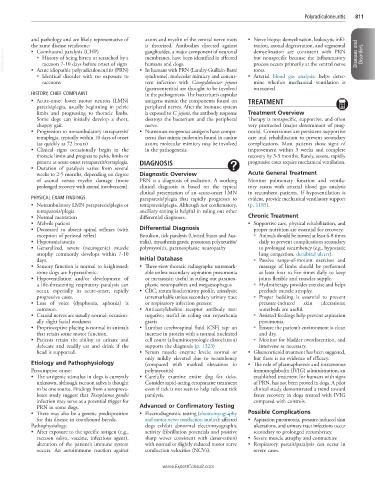Page 1610 - Cote clinical veterinary advisor dogs and cats 4th
P. 1610
Polyradiculoneuritis 811
and pathology and are likely representative of axons and myelin of the ventral nerve roots • Nerve biopsy: demyelination, leukocytic infil-
the same disease syndrome: is theorized. Antibodies directed against tration, axonal degeneration, and segmental
VetBooks.ir ○ History of being bitten or scratched by a membranes, have been identified in affected but nonspecific because the inflammatory Diseases and Disorders
demyelination are consistent with PRN
• Coonhound paralysis (CHP)
gangliosides, a major component of neuronal
humans and dogs.
process occurs primarily at the ventral nerve
raccoon 7-10 days before onset of signs
• Acute idiopathic polyradiculoneuritis (PRN)
roots.
○ Identical disorder with no exposure to • In humans with PRN (Landry-Guillain-Barré • Arterial blood gas analysis: helps deter-
syndrome), molecular mimicry and concur-
raccoons rent infection with Campylobacter jejuni mine whether mechanical ventilation is
(gastroenteritis) are thought to be involved warranted
HISTORY, CHIEF COMPLAINT in the pathogenesis. The bacterium’s capsular
• Acute-onset lower motor neuron (LMN) antigens mimic the components found on TREATMENT
paresis/plegia, usually beginning in pelvic peripheral nerves. After the immune system
limbs and progressing to thoracic limbs. is exposed to C. jejuni, the antibody response Treatment Overview
Some dogs can initially develop a short, destroys the bacterium and the peripheral Therapy is nonspecific, supportive, and often
choppy gait. nerve. very protracted (major determinant of prog-
• Progression to nonambulatory tetraparesis/ • Numerous exogenous antigens have compo- nosis). Cornerstones are persistent supportive
tetraplegia, typically within 10 days of onset nents that mimic molecules found in canine care and rehabilitation to prevent secondary
(as quickly as 72 hours) axons; molecular mimicry may be involved complications. Most patients show signs of
• Clinical signs occasionally begin in the in the pathogenesis. improvement within 3 weeks and complete
thoracic limbs and progress to pelvic limbs or recovery by 3-5 months. Rarely, severe, rapidly
present as acute-onset tetraparesis/tetraplegia. DIAGNOSIS progressive cases require mechanical ventilation.
• Duration of paralysis varies from several
weeks to 2-5 months, depending on degree Diagnostic Overview Acute General Treatment
of axonal versus myelin damage (more PRN is a diagnosis of exclusion. A working Monitor pulmonary function and ventila-
prolonged recovery with axonal involvement). clinical diagnosis is based on the typical tory status with arterial blood gas analysis
clinical presentation of an acute-onset LMN in recumbent patients. If hypoventilation is
PHYSICAL EXAM FINDINGS paraparesis/plegia that rapidly progresses to evident, provide mechanical ventilatory support
• Nonambulatory LMN paraparesis/plegia or tetraparesis/plegia. Although not confirmatory, (p. 1185).
tetraparesis/plegia ancillary testing is helpful in ruling out other
• Normal mentation differential diagnoses. Chronic Treatment
• Afebrile patient • Supportive care, physical rehabilitation, and
• Decreased to absent spinal reflexes (with Differential Diagnosis proper nutrition are essential for recovery.
exception of perineal reflex) Botulism, tick paralysis (United States and Aus- ○ Animals should be turned at least 6-8 times
• Hypotonia/atonia tralia), myasthenia gravis, protozoan polyneuritis/ daily to prevent complications secondary
• Generalized, severe (neurogenic) muscle polymyositis, paraneoplastic neuropathy to prolonged recumbency (e.g., hypostatic
atrophy commonly develops within 7-10 lung congestion, decubital ulcers).
days. Initial Database ○ Passive range-of-motion exercises and
• Sensory function is normal to heightened; • Three-view thoracic radiographs: unremark- massage of limbs should be performed
some dogs are hyperesthetic. able unless secondary aspiration pneumonia at least four to five times daily to keep
• Hypoventilation and/or development of or metastasis; useful in ruling out paraneo- joints flexible and muscles supple.
a life-threatening respiratory paralysis can plastic neuropathies and megaesophagus ○ Hydrotherapy provides exercise and helps
occur, especially in acute-onset, rapidly • CBC, serum biochemistry profile, urinalysis: preclude muscle atrophy.
progressive cases. unremarkable unless secondary urinary tract ○ Proper bedding is essential to prevent
• Loss of voice (dysphonia, aphonia) is or respiratory infection present pressure-induced skin ulcerations;
common. • Antiacetylcholine receptor antibody test: waterbeds are useful.
• Cranial nerves are usually normal; occasion- negative; useful in ruling out myasthenia ○ Assisted feedings help prevent aspiration
ally slight facial weakness gravis pneumonia.
• Proprioceptive placing is normal in animals • Lumbar cerebrospinal fluid (CSF) tap: an ○ Ensure the patient’s environment is clean
that retain some motor function. increase in protein with a normal nucleated and dry.
• Patients retain the ability to urinate and cell count (albuminocytologic dissociation) ○ Monitor for bladder overdistention, and
defecate and readily eat and drink if the supports the diagnosis (p. 1323) intervene as necessary.
head is supported. • Serum muscle enzyme levels: normal or • Glucocorticoid treatment has been suggested,
only mildly elevated due to recumbency but there is no evidence of efficacy.
Etiology and Pathophysiology (compared with marked elevations in • The role of plasmapheresis and intravenous
Presumptive cause: polymyositis) immunoglobulin (IVIG) administration, an
• The antigenic stimulus in dogs is currently • Carefully examine entire dog for ticks. established treatment for humans with signs
unknown, although raccoon saliva is thought Consider rapid-acting ectoparasite treatment of PRN, has not been proved in dogs. A pilot
to be one source. Findings from a seropreva- even if tick is not seen to help rule out tick clinical study demonstrated a trend toward
lence study suggest that Toxoplasma gondii paralysis. faster recovery in dogs treated with IVIG
infection may serve as a potential trigger for compared with controls.
PRN in some dogs. Advanced or Confirmatory Testing
• There may also be a genetic predisposition • Electrodiagnostic testing (electromyography Possible Complications
for this disease in coonhound breeds. and motor nerve conduction studies): affected • Aspiration pneumonia, pressure-induced skin
Pathophysiology: dogs exhibit abnormal electromyographic ulcerations, and urinary tract infections occur
• After exposure to the specific antigen (e.g., activity (fibrillation potentials and positive secondary to prolonged recumbency.
raccoon saliva, vaccine, infectious agent), sharp waves consistent with denervation) • Severe muscle atrophy and contracture
alteration of the patient’s immune system with normal or slightly reduced motor nerve • Respiratory paresis/paralysis can occur in
occurs. An autoimmune reaction against conduction velocities (NCVs). severe cases.
www.ExpertConsult.com

